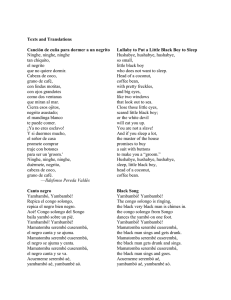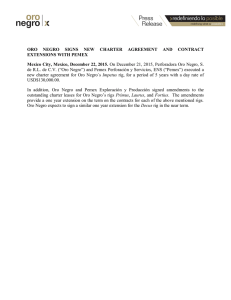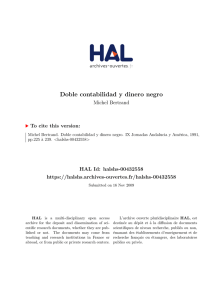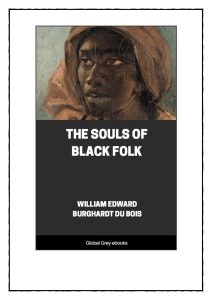1 Diamante, Juan Bautista Relacion el Negro mas prodigioso
Anuncio
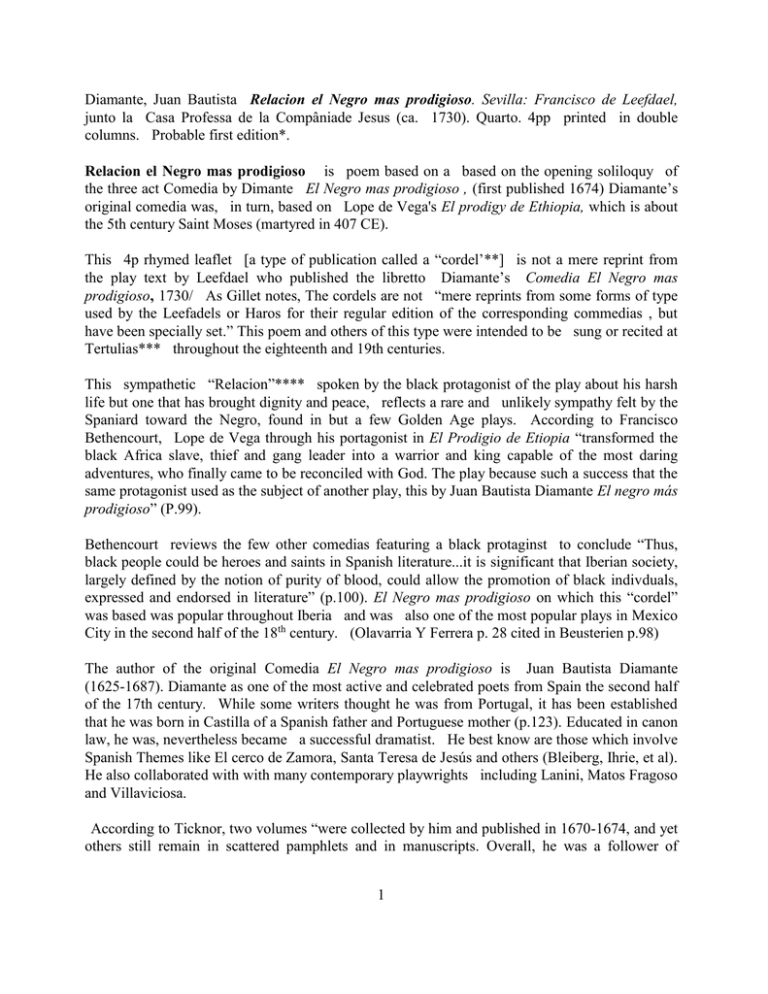
Diamante, Juan Bautista Relacion el Negro mas prodigioso. Sevilla: Francisco de Leefdael, junto la Casa Professa de la Compâniade Jesus (ca. 1730). Quarto. 4pp printed in double columns. Probable first edition*. Relacion el Negro mas prodigioso is poem based on a based on the opening soliloquy of the three act Comedia by Dimante El Negro mas prodigioso , (first published 1674) Diamante’s original comedia was, in turn, based on Lope de Vega's El prodigy de Ethiopia, which is about the 5th century Saint Moses (martyred in 407 CE). This 4p rhymed leaflet [a type of publication called a “cordel’**] is not a mere reprint from the play text by Leefdael who published the libretto Diamante’s Comedia El Negro mas prodigioso, 1730/ As Gillet notes, The cordels are not “mere reprints from some forms of type used by the Leefadels or Haros for their regular edition of the corresponding commedias , but have been specially set.” This poem and others of this type were intended to be sung or recited at Tertulias*** throughout the eighteenth and 19th centuries. This sympathetic “Relacion”**** spoken by the black protagonist of the play about his harsh life but one that has brought dignity and peace, reflects a rare and unlikely sympathy felt by the Spaniard toward the Negro, found in but a few Golden Age plays. According to Francisco Bethencourt, Lope de Vega through his portagonist in El Prodigio de Etiopia “transformed the black Africa slave, thief and gang leader into a warrior and king capable of the most daring adventures, who finally came to be reconciled with God. The play because such a success that the same protagonist used as the subject of another play, this by Juan Bautista Diamante El negro más prodigioso” (P.99). Bethencourt reviews the few other comedias featuring a black protaginst to conclude “Thus, black people could be heroes and saints in Spanish literature...it is significant that Iberian society, largely defined by the notion of purity of blood, could allow the promotion of black indivduals, expressed and endorsed in literature” (p.100). El Negro mas prodigioso on which this “cordel” was based was popular throughout Iberia and was also one of the most popular plays in Mexico City in the second half of the 18th century. (Olavarria Y Ferrera p. 28 cited in Beusterien p.98) The author of the original Comedia El Negro mas prodigioso is Juan Bautista Diamante (1625-1687). Diamante as one of the most active and celebrated poets from Spain the second half of the 17th century. While some writers thought he was from Portugal, it has been established that he was born in Castilla of a Spanish father and Portuguese mother (p.123). Educated in canon law, he was, nevertheless became a successful dramatist. He best know are those which involve Spanish Themes like El cerco de Zamora, Santa Teresa de Jesús and others (Bleiberg, Ihrie, et al). He also collaborated with with many contemporary playwrights including Lanini, Matos Fragoso and Villaviciosa. According to Ticknor, two volumes “were collected by him and published in 1670-1674, and yet others still remain in scattered pamphlets and in manuscripts. Overall, he was a follower of 1 Calderon. His play Honrador de su Padre was long thought in Voltaire’s time (even by Voltaire himself) to be the model Corneille used for his El Cid. *Other editions of a 4p Relacion el Negro mas prodigioso located in World Cat: Valencia [c. 1750Cordoba : impr. de D. J. de Galvez y Aranda, (s. d.); Málaga : F. de Casas, y Martínez, (1800s); Undated mss Relación trobada de la comedia El negro más prodigioso, de Francisco Robles ** “Cordels” are popular and inexpensively printed booklets or pamphlets containing folk novels, poems and songs, which are produced and sold in fairs and by sidestreet. They form one of the least altered continuations of the Western traditions of popular literature, such as chapbooks, Gillet consideres the “cordels” “as examples of reciprocal development of the Spanish romances and the Spanish comedia, with popular poetry supplying inspiration and adornment to the theatre; the latter, in return enriching popular poetry with selections from plays” ***tertulia. A tertulia (Spanish: [terˈtulja]; Galician: [teɾˈtulja]; Portuguese: tertúlia [tɨɾˈtuliɐ] is rather similar to a salon, but a typical tertulia in recent centuries has been a regularly scheduled event in a public place such as a bar, although some tertulias are held in more private spaces, such as someone's living room. Participants, known as contertulios, may share their recent creations such as poetry, short stories, other writings, and even artwork or songs. ****relacion. Poems that began as relacion* , developing from a commedia attained independent existence as a little drama and gradually merging into a romance, from which, in a sense, the drama that bore it had grown There were of course Romances whose title began with the word Relacion as early as the sixteenth century. The relacion “ must have greatly appealed to an innate love of fine rhetoric in actor and audience. All this contributed to make the relaciones into separable elements, somewhat isolated by the economy of the play and by their metrical form. …Most of the relaciones were meant to be declaimed, sung represented as the romances …must have been represented not only in the streets, but also at social gathering [Tertulias]…which grew in popularity. (Gillet) 457 References: Barrera y Leirado, Cayetano Alberto. Catalogo bibliografico del teatro antiguo Espanol desde sus origenes hasta mediados del siglo XVIII. Madrid: Rivadeneyra, 1860; Bethencourt. Francisco Racisms: From the Crusades to the Twentieth Century.Princeton University Press, Jan 19, 2014; Beusterien, John. An Eye on Race. Perspectives from Theater in Imperial Spain. 2006; Bleiberg, Germán, Maureen Ihrie, Janet Pérez. Dictionary of the Literature of the Iberian Peninsula (1993); Gillet, Joseph E, A Neglected chapter in the History of the Spanish Romance. New York : Revue Hispanique, 1922; Hochman, Stanley, ed. McGraw-Hill Encyclopedia of World Drama. 1984; Pringle R.V. “A checklist of plays by or attributed to Juan Bautista Diamant.” http://www.rvpmp.talktalk.net/diamante/obras.html; Ticknor, George. History of Spanish Literature. New York: Ungar, 1965 (reprinted from the 1849 edition). $1500.00 2

